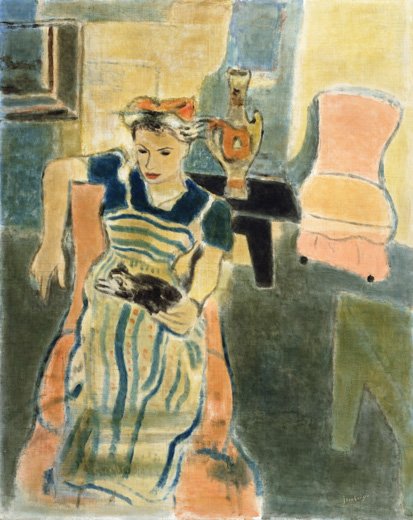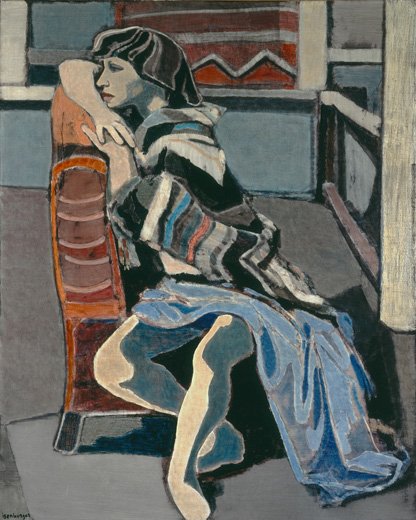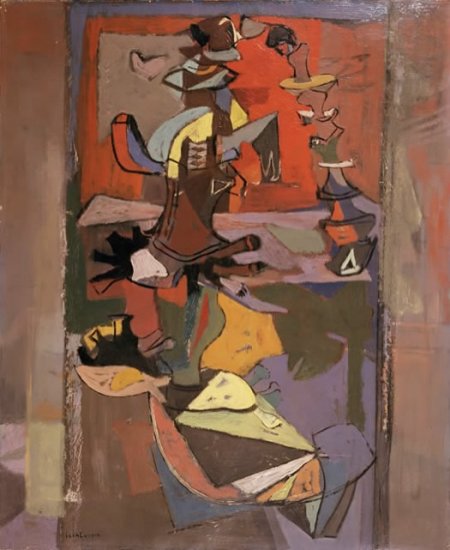Franziska Niedermeier:
Eric Isenburger in the USA
A Frenchman in New York
On 4 June 1941, Eric and Jula Isenburger, together with numerous other refugees, arrived at Ellis Island after a 19-day crossing on the Ciudad de Sevilla. Upon their arrival in the USA, Jula decided to give up dancing in order to devote herself entirely to her husband’s career. She therefore took a job at the clothing firm Saks Fifth Avenue.

Girl with a Cat
For the artist, although emigration to the USA meant the long-awaited path to freedom, at the same time he found himself back at the starting point of his artistic career. But this time he had made preparations. As early as 1938 he had sent seven paintings to the Carstairs Gallery in New York, which were discovered there by the gallery dealer Blanche Bonnestelle. Together with Carroll Carstairs, she organized a solo exhibition in the celebrated Knoedler Gallery, where Carstair’s father was board chairman. In October 1941 he presented a total of 23 works there under the title Eric Isenburger. Exhibition of Paintings, all of which, with one exception, had arisen in southern France. In the exhibition catalogue, the location where each work arose is listed after each painting’s title – either Nice or Grasse – as additional information. In all likelihood this was done for primarily commercial purposes. Since the art of southern France was the current hot trend on the American market at the time, Knoedler explicitly intended to underscore the German-Jewish painter Isenburger’s “Frenchness,” and emphasize the (post-) impressionistic style of his works in writing. Moreover, in a brief introductory text, he highlights his refugee status in a quote taken from the artist’s correspondence with the French author and Nobel Prize laureate André Gide. Although the American art market had not completely recovered from the Great Depression of the 1930’s at that time, this first solo exhibition in the USA was a complete success, and ten of the 23 paintings were sold. In addition to the positive reviews he obtained through this exhibition, he also concluded a 20-year contract with Knoedler which guaranteed him a solo exhibition every two years.
The following year, Eric presented 20 works from the years 1938 through 1942 in a solo show at the Baltimore Museum of Art. Here, a brief text prefixed to the paintings by the art historian John Rewald, also of German descent, reveals another marketing strategy. Unlike Knoedler, who intentionally spotlighted the artist as a victim of National Socialist persecution, Rewald makes no mention of proscription or exile. Instead of highlighting the artist’s tragic biography, Rewald seeks to score points with the Impressionism in his paintings. He describes his works as “a festival of color and light”, praising the artist’s transparent use of color and his significant palette. In addition, Rewald mentions in his introduction the purchase of Isenburger’s Girl with a Cat by the Museum of Modern Art in New York.
Isenburger – an American?

Romantic Figure
On the occasion of the second exhibition in the Knoedler Gallery in1943, in which paintings that had arisen exclusively in the USA were now presented, the critic Charles Z. Offin noted initial changes in style in these works. While he describes the European works as “A ensemble of paintings from France, which in their spirit, style and origin were so french like everthing seen before” …. “Isenburger appears (in his recent paintings) with american strenght of pictoral approach, while obtaining all refinements and emotional nuances, which characterized his fomer works, but now adding more assertiveness through more intense color and tones.” Offin thus interprets the development towards a more intense palette to be seen in the mid -1940’s as the exile’s adaptation to American culture. Isenburger’s critical reception of his own artistic work up to this point and with his new homeland, America, is also documented in a series of intimate self-portraits. The result of this self-reflection was enthusiastically received by the American public and the year 1945 turned into an unqualified success for the painter. At the 120th annual exhibition of the National Academy, following another solo show at Knoedler’s, a travelling exhibition by the De Young Memorial Museum and 6 other group exhibitions, he was awarded the host institution’s prize with a purse of $1,000 for a still life (Still Life in a Country Home?, 1944). Through this series of important shows, the artist finally succeeded in making a name for himself in the American art scene and establishing himself in New York as a free-lance artist.
In the second half of the decade, the recognition his work received from art critics and the public inspired the artist to experiment with new possibilities of artistic composition. Within a number of serial productions, he expanded not only his palette of colors, but also his formal vocabulary. In 1946, he made use of a stay at the Woodstock artists’ colony to transpose mechanical, metallic constructions deriving from farm machines into abstract compositions. Here, he intentionally separated the individual parts of the machines from each other, and then transformed their objective forms into abstract-geometrical ones. Whereas his aim up to this point had been to capture a harmonious overall impression in an entirely impressionistic sense, the technical devices in this series now served him more as the visual points of departure for a subjective abstraction. This analytical approach to the object is new in Isenburger’s work, although it is exemplified in art history by analytical Cubism, where artists such as Braques and Picasso had already dissected their motifs and then reconfigured them in new ways. This new methodology is consistently carried out in a series depicting women with musical instruments. Through increased use of a dark cloisonné, strongly contrasting colors and an extremely planar application of his colors, the painter succeeded in intensifying the abstract impression of the Farm Machines – Series in the portraits of women even more. Moreover, he decided to leave out all elaborative details and to reduce the background to a geometrical, block-like construction, which supported the subjective and artificial effect of this series.
Professionally, the decade ended with a huge success for the exile. His work Romantic Figure was distinguished with the medal of honor of the National Academy, the Corcoran Gold Medal and the W.A. Clark Award of the Corcoran Gallery, Washington, D.C., and also was the cover image of the April edition of Art Digest. But the artist had not only assimilated to the demanding American art market in a very short time; it appeared as though the couple had found a new homeland in the USA in terms of their private life as well. In 1949, as the result of their integration, Jula and Eric Isenburger decided to become American citizens, as did most German exiles. In a 1962 newspaper interview, Eric expresses his relationship to the two continents as follows: “Europe, all well and good, a fairy-land, a region for travel and taking a vacation ( … ), but for day-to-day living, for working, New York is the ideal city for me. The climate there is inspiring, focuses.”
Journeys
One of the many journeys the artist took with his wife after the end of the Second World War was a voyage to Rome in 1950. The ancient architecture and sculpture the artist found there inspired extraordinary drawings, some of which he later transported into oil paintings. Whereas previously sculptures and buildings were merely illustrative means for a focused scene, in these pictures they are lent an unprecedented autonomy. Isenburger’s interest in ancient motifs here is purely aesthetic in nature; for him they have no religious or spiritual significance whatsoever, but instead function solely as objects with which he explores possibilities of composition. This time, in addition to oil paintings, eight Italian graphics were to be seen in the Knoedler Gallery presentation, a first in his exhibition chronology.
The couple spent the following summer in South America, more precisely in the hinterlands of Guatemala, where Eric found inspiration in the primordial jungle vegetation. In terms of style, he reached a new level of abstraction in his depictions of local plant life, animals and villages. In Banana Stalk he frees the object to be depicted from its natural surroundings and places it before a flat, indefinable background. Here, in terms of color and formal vocabulary, he did not distinguish between plant and background; in certain areas only a single dark contour line delineated the plant. But where it runs, object and background merge into an abstract composition to such an extent that no distinction can be made between the two any longer.

Banana Stalk
The couple spent the summers of 1953 and ‘54 on the island of Majorca. On one of their numerous trips to the Spanish mainland, they attended a bull fight in Seville. The image of the struggle between torero and bull burned itself into the artist’s memory and was to become a motif in many of his works. One of the most remarkable of these works is Dying Bull, which the artist depicts at the moment of its death in the arena. An intentionally small image detail directs the focus to the animal, whose back is pierced with banderillas. Both the spears and the straight lines of the background that cross the geometric backdrop lead to a point behind the bull, rendering this point the explicit centre of the pictorial narrative. Furthermore, the tragedy of this moment is intensified by means of the sharp, straight lines that dissect both the animal and arena. The consistency with which Isenburger formally analyses Dying Bull lends the work its extraordinarily cubistic character. He showed some of these works in a 1954 solo exhibition in the Country Art Gallery on Long Island. Although this show was very positively reviewed, at first no works were sold. Only with the publication of two bullfight scenes in the April edition of Sports Illustrated did the series’ breakthrough take place. Eric received more inquiries than ever before concerning purchase of the two works. Even years later, when he had already been teaching for a year as a visiting professor at Mary Washington College in Virginia, numerous letters still were being delivered to him expressing interest in the series. Numerous sales confirmations in the artist’s estate in Frankfurt document that this series was a true “sales hit.”
Career downturn
In 1955, the artist sought to build on this success with pictures he had done after a stay in Mexico. Although the works are qualitatively on the same level with the Bull Fight – Series, the public did not receive them with the same euphoric tempests of enthusiasm, which was also reflected in an absence of reviews in leading art magazines. The reason for the dwindling perception and appreciation of Eric Isenburger’s works is to be found in the evolution of the art market at that time. As a group of young New York artists was entering the art circuit at the start of the 1950’s, the priorities of the American art market that had predominated up to that point were shifting. Although until that point, the great masters of European modernity had always served as benchmarks in judging and evaluating art, the Americans were now finding their identity in the Abstract Expressionism of action painters. Painters dedicated to gestural abstraction such as Franz Kline, Willem de Kooning or Jackson Pollock now enjoyed the full and exclusive attention of the art market and critics. Artists who, like Isenburger, continued to work representationally and in relation to real objects were now considered backward and conservative. The logical consequences for them were continually diminishing exhibition opportunities in the prominent institutions that had been available to them in the ‘40’s. After the mid- ‘50’s, Eric also failed to obtain any further significant museum exhibitions and in 1961, when his contract with Knoedler ran out, his many years of cooperation with the gallery also came to an end. He was able to chalk up successes only in a few institutions that avant-gardists looked down on as traditional and conservative. He was able to exhibit and to win numerous awards almost on a yearly basis into the late ‘80’s at Mary Washington College in Virginia, as well as in the National Academy of Design, where he even became a member. He also taught at the latter institution from 1959 until 1980.
A circle is completed
Although major commercial success in the USA came to an end for Isenburger in the late 1950’s, he was able to fulfill a deeply personal dream in 1962: to exhibit in Europe once again. From 4 until 26 June 1962, he held an exhibition in Munich entitled Eric Isenburger. New York, in the new exhibition spaces of his former Berlin gallery owner Wolfgang Gurlitt. In selecting the works, he relied on a colorful mixture of practically all genres. In addition to a few landscape photographs, still lifes and portraits, it was above all the recently arisen views of Venice to which visitors responded with enthusiasm. Even though the Serenissima had already been a theme in his paintings several times, their execution came as a surprise. Instead of the expected abstract tendencies to be seen in Dying Bull or Light in Tclacolula, the artist appeared to have returned to his roots in the five years that lay between those paintings and his new ones. None of the works on exhibit in Gurlitt’s gallery reveal the previous cubistic dissection of form or the bold and strongly contrasting use of color that he had developed over the years in New York. Instead, above all his cityscapes appear decidedly impressionistic in their gentle colors and melodic harmoniousness, recalling old works from Eric’s time in Europe. In soft pastel tones and relaxed brushwork, he modeled building facades, bridges and boats. Here, he dispensed with any sort of artificiality in contouring or the use of color, instead permitting a natural harmony to arise through balanced and sensitive composition.
It even seemed as though the path to abstraction on which Isenburger had set off since his arrival in the USA had in the end turned out to be an artistic dead end for him. Having reached a point at which his previous artistic achievements in his works no longer furthered his goals, he resolved on a radical break with his past practice and a return to earlier ideals. Instead of cubistic abstraction, the artist now pursued the impressionistic concept of painting that had inspired him during his stay in southern France about 30 years before. For Eric, an imaginary circle was evidently being completed, not only in biographically, but in formal terms as well. With his return to Germany, the artist at the same time turned to his southern French role models, in whose tradition he had seen himself over twenty years before.
Franziska Niedermeier,
Aspekte des malerischen Werkes Eric Isenburgers, Magisterarbeit (Auszug) an der Ludwig-Maximilians-Universität München, Department Kunstwissenschaften, 2011
Aspects of Eric Isenburger’s Painterly Oeuvre, master’s thesis (excerpt), Ludwig Maximilian University Munich, Faculty of History and the Arts